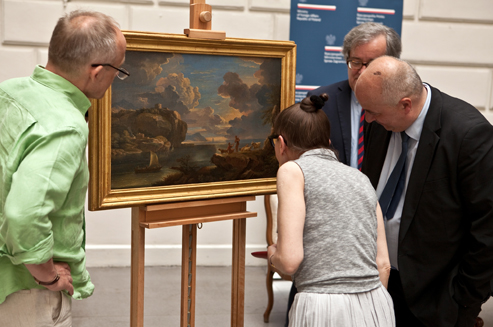“The painting has an interesting history. Like many other works of art in this region, it went missing during World War II. It was found in Italy, and sent back to Poland thanks to local authorities,” said Minister Schetyna. “I am happy that so many lost works of art return to our country. The MFA has not said its last word yet,” stressed the chief of Polish diplomacy.
Piotr Oszczanowski, head of the National Museum in Wroclaw, thanked Polish diplomatic services for their activity to retrieve cultural goods. “This painting will be welcomed not only by museologists, but also by a wider public,” he said.
The Calm Sea by a Rocky Shore was part of the collection of Albrecht Sebisch (1685-1748), a Wroclaw-based patrician, member and head of the city’s municipal council, and grandson of the commander of the Kamyanets-Podilskyi Castle. Ernst Wilhelm Hubrig, the heir to Sebisch’s fortune, donated the collection to the city of Wroclaw in 1767. Since 1880, the collection was on display at the Silesian Museum of Fine Arts (Schlesisches Museum der bildenden Künste). In 1942, it was moved to war storehouses in the provinces, together with the rest of the museum’s collections. The painting probably went missing in 1945, after the territory was occupied by the Red Army.
In March 2015, the painting was put up for auction in Milan. It was withdrawn from the auction thanks to Italian tax authorities and the Polish Institute in Rome, on the basis of MFA documents certifying its origin.
Pieter Mulier was a Dutch artist who studied and worked in Harleem. Around 1656, he moved to Italy, where he lived in Rome, Genova, Milan, and Venice. He specialised in landscapes, especially ones representing stormy seas, hence his pseudonym – Tempest. The retrieved painting is a typical example of the artist’s work.
The Calm Sea by a Rocky Shore is the fourth painting from the collection of the former Museum of Fine Arts in Wroclaw retrieved after 2008, the second painting retrieved this year next to Jacob Jordaens’s St. Yvonne, and the 25th painting from Sebisch’s collection to have returned to Poland – the other 24 were sent back to our country from the Soviet Union in 1956.
Source: Press Office of the Ministry of Foreign Affairs Republic of Poland
Photo © Wojciech Rogowicz/National Museum Wrocław


